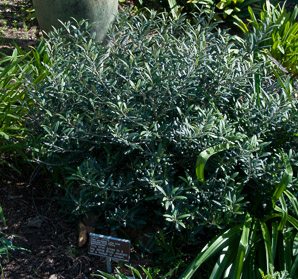Olea europaea ‘Little Ollie’
Dwarf olive
Kingdom Plantae Plants, but not fungi, lichens, or algae
Subkingdom Tracheobionta Vascular plants—plants with a “circulatory system” for delivering water and nutrients
Division Magnoliophyta Flowering plants, also known as angiosperms
Class Magnoliopsida Dicotyledons—plants with two initial seed leaves
Subclass Asteridae A large class that encompasses asters
Order Lamiales Aromatic herbs and shrubs, including lavender, lilac, olive, jasmine, ash, teak, snapdragon, sesame, psyllium, garden sage, mint, basil, and rosemary
Family Oleaceae Temperate climate shrubs, trees and a few vines, include forsythia, ash, jasmine, privet, olive, lilac, and many others
Genus Olea A Latin name for the important fruit tree, the olive, known from antiquity as a symbol of peace and good will
Species europaea From Europe
Cultivar ‘Little Ollie’
About plant names...
'Little Ollie' is a dwarf, non-fruiting olive tree cultivated for use as a hedge or for bonsai. The wild plant from
which it comes, Olea europaea, is common olive or European olive, and is
native to the Mediterranean region. It is not
found in the wild.
Identification: These evergreens reach 4-8′ (1.2-2.4 m).
Leaves are dark green, oval, with pointed ends. It has multiple stems and is a slow growing
plant.
Online References:
Www.ehow.com
Ucanr.edu
Chris A. Martin's site at Arizona State University
Olea europaea ‘Little Ollie’ description by Thomas H. Kent, last updated 25 May 2020.
© FloraFinder.org. All rights reserved.
2/24/2010 · San Diego (Quail) Botanic Garden, Encinitas, California · ≈ 3 × 4½′ (94 × 141 cm)
Range: Zones 10-11:
About this map...




